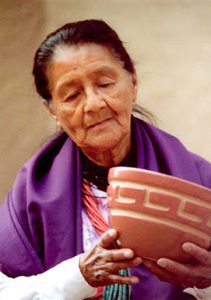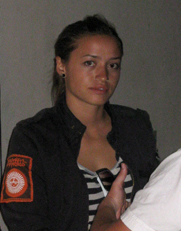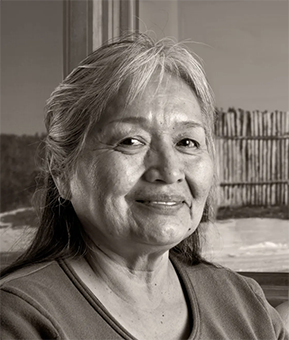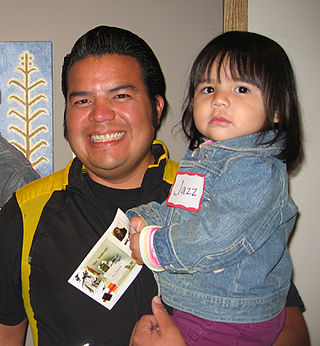
The Institute of American Indian Arts (IAIA) is a public tribal land-grant college in Santa Fe, New Mexico, United States. The college focuses on Native American art. It operates the Museum of Contemporary Native Arts (MoCNA), which is housed in the historic Santa Fe Federal Building, a landmark Pueblo Revival building listed on the National Register of Historic Places as Federal Building. The museum houses the National Collection of Contemporary Indian Art, with more than 7,000 items.

Maria Poveka Montoya Martinez was a Puebloan artist who created internationally known pottery. Martinez, her husband Julian, and other family members, including her son Popovi Da, examined traditional Pueblo pottery styles and techniques to create pieces which reflect the Pueblo people's legacy of fine artwork and crafts. The works of Maria Martinez, and especially her black ware pottery, are in the collections of many museums, including the Smithsonian, the Metropolitan Museum of Art, the Denver Art Museum, and more. The Penn Museum in Philadelphia holds eight vessels – three plates and five jars – signed either "Marie" or "Marie & Julian".

Lucy Martin Lewis was a Native American potter from Acoma Pueblo, New Mexico. She is known for her black-on-white decorative ceramics made using traditional techniques.

Maria Margarita "Margaret" Tafoya was the matriarch of Santa Clara Pueblo potters. She was a recipient of a 1984 National Heritage Fellowship awarded by the National Endowment for the Arts, which is the United States government's highest honor in the folk and traditional arts.
Anita Louise Suazo is a Native American potter from Santa Clara Pueblo, New Mexico, United States.
Diego Romero is an American Cochiti Pueblo visual artist. He is known for ceramics and pottery, and lives in New Mexico.
Nora Naranjo Morse is a Native American artist and poet. She currently resides in Española, New Mexico just north of Santa Fe and is a member of the Santa Clara Pueblo, part of the Tewa people. Her work can be found in several museum collections including the Heard Museum in Phoenix, Arizona, the Minneapolis Institute of Art in Minnesota, and the National Museum of the American Indian in Washington, DC, where her hand-built sculpture piece, Always Becoming, was selected from more than 55 entries submitted by Native artists as the winner of an outdoor sculpture competition held in 2005. In 2014, she was honored with a NACF Artist Fellowship for Visual Arts and was selected to prepare temporal public art for the 5x5 Project by curator Lance Fung.

The Poeh Museum is a museum in Pojoaque, New Mexico, U.S.A. The museum is located off U.S. Route 84. It is devoted to the arts and culture of the Puebloan peoples, especially the Tewas in the northern part of the state. It was founded by Pojoaque Pueblo in 1987, and is housed in the Poeh Center. The museum organizes changing exhibitions, and is a large repository of permanent artifacts and programs. The museum has run the Oral Histories Documentation, which is part of the museum's records, which involved participation of 38 Tewa elders providing stories about their lives; the information is available in both Tewa and English.

Art of the American Southwest is the visual arts of the Southwestern United States. This region encompasses Arizona, New Mexico, and parts of California, Colorado, Nevada, Texas, and Utah. These arts include architecture, ceramics, drawing, filmmaking, painting, photography, sculpture, printmaking, and other media, ranging from the ancient past to the contemporary arts of the present day.
Jody Naranjo is a contemporary Tewa pottery maker from the Santa Clara Pueblo, New Mexico in the United States. She comes from a family of traditional Tewa potters. She learned the craft of pottery from her mother, Dolly Naranjo, and other female relatives. She attended the Institute of American Indian Arts. Naranjo was selling her artwork at age fifteen at the New Mexico History Museum. Her style is identifiable and showcases her keen sense of humour. Jody has 3 daughters and maintains her connections to her heritage and friends. She is represented by Blue Rain Gallery in Santa Fe.
Jody Folwell-Turipa is a Puebloan potter and artist.
Tammy Garcia is a Santa Clara Pueblo sculptor and ceramic artist. Garcia translates Pueblo pottery forms and iconography into sculptures in bronze and other media.
Wendy Ponca is an Osage artist, educator, and fashion designer noted for her Native American fashion creations. From 1982 to 1993, she taught design and Fiber Arts courses at the Institute of American Indian Arts (IAIA) of Santa Fe and later taught at the University of Las Vegas. She won first place awards for her contemporary Native American fashion from the Santa Fe Indian Market each year between 1982 and 1987. Her artwork is on display at IAIA, the Los Angeles County Museum of Art, the Philbrook Museum of Art and the Smithsonian Institution's National Museum of the American Indian.

Rose B. Simpson is a mixed-media artist who works in ceramic, metal, fashion, painting, music, performance, and installation. She lives and works in Santa Clara Pueblo, New Mexico. Her work has been exhibited at SITE Santa Fe ; the Heard Museum ; the Museum of Contemporary Native Art, Santa Fe (2010); the National Museum of the American Indian, Smithsonian (2008); the Denver Art Museum; Pomona College Museum of Art (2016); Ford Foundation Gallery (2019); The Wheelwright Museum of the American Indian (2017); the Minneapolis Institute of Art (2019); the Savannah College of Art and Design (2020); the Nevada Museum of Art (2021); Whitney Museum of American Art, and the Norton Museum of Art (2024).

Christine McHorse, also known as Christine Nofchissey McHorse, was a Navajo ceramic artist from Santa Fe, New Mexico.
Susan Folwell is a Native American artist from Santa Clara Pueblo, New Mexico, known for her work in the ceramic industry. Her work ties in Native designs and history and has been used by Folwell to demonstrate her viewpoints on society and politics. Folwell has been described by the Heard Museum as an "innovator in Pueblo pottery".

Jason Garcia is a contemporary Native American artist in the United States, who was born in Santa Clara, New Mexico. His work has been exhibited the Smithsonian in Washington D.C, the Heard Museum in Phoenix, the Palm Springs Art Museum, and many more. He won the 2018 Mentor Fellowship Award under the Native Arts and Cultures Foundation amongst many others.
Holly Wilson is a Native American artist from Oklahoma. She is an enrolled member of the Delaware Nation and is of Cherokee descent.

Black-on-black ware is a 20th- and 21st-century pottery tradition developed by Puebloan Native American ceramic artists in Northern New Mexico. Traditional reduction-fired blackware has been made for centuries by Pueblo artists and other artists around the world. Pueblo black-on-black ware of the past century is produced with a smooth surface, with the designs applied through selective burnishing or the application of refractory slip. Another style involves carving or incising designs and selectively polishing the raised areas. For generations several families from Kha'po Owingeh and P'ohwhóge Owingeh pueblos have been making black-on-black ware with the techniques passed down from matriarch potters. Artists from other pueblos have also produced black-on-black ware. Several contemporary artists have created works honoring the pottery of their ancestors.










